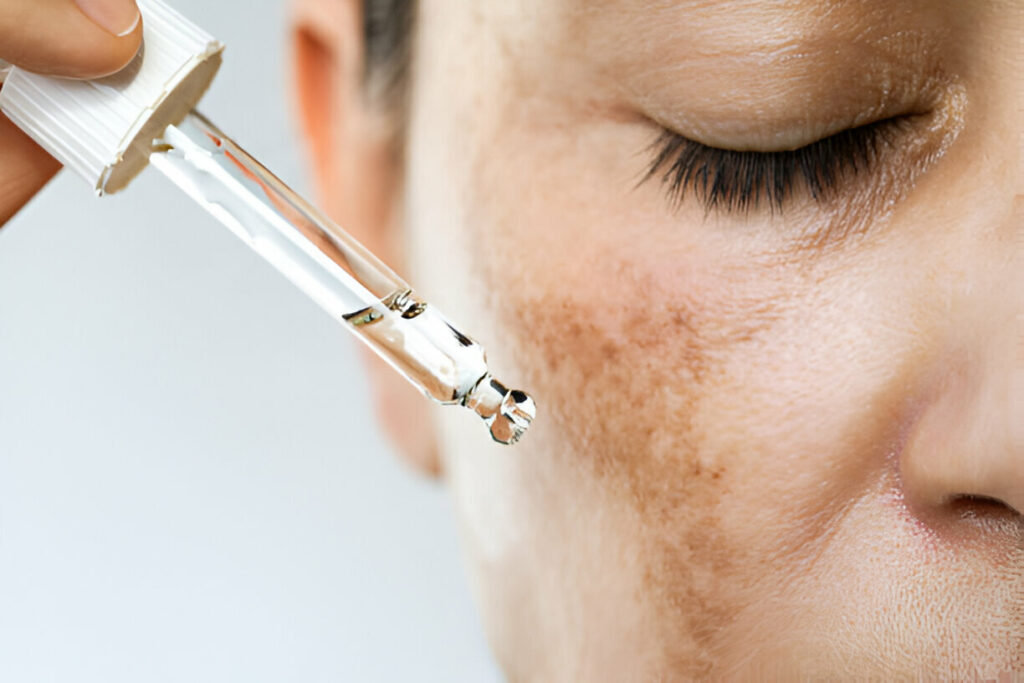108, Shangrila Arcade,
Nr. Shyamal Cross Road,
Satellite, Ahmedabad - 380015
Understanding and Treating Melasma
What is Melasma?
Melasma is a common skin condition characterized by the appearance of brown or gray-brown patches on the skin, primarily on the face. These patches often appear on the cheeks, forehead, bridge of the nose, and above the upper lip. Melasma can also develop on other sun-exposed areas of the body, such as the neck and forearms. While melasma is not harmful, it can cause significant emotional distress and impact self-esteem.
Causes of Melasma
The exact cause of melasma is not fully understood, but several factors are known to trigger or exacerbate the condition. According to the American Academy of Dermatology (AAD), the following are primary contributors to melasma:
- Sun Exposure: Ultraviolet (UV) radiation from the sun stimulates melanocytes, the pigment-producing cells in the skin. Increased melanin production leads to the characteristic dark patches of melasma.
- Hormonal Changes: Hormonal fluctuations, particularly in women, play a significant role in the development of melasma. Pregnancy, birth control pills, and hormone replacement therapy can all trigger melasma.
- Genetic Predisposition: A family history of melasma increases the likelihood of developing the condition. It is more common in individuals with darker skin types, including those of Latin, Asian, African, Mediterranean, and Middle Eastern descent.
- Cosmetic Products: Certain skin care products and cosmetics can irritate the skin, leading to melasma in sensitive individuals.
Diagnosis of Melasma
Dermatologists typically diagnose melasma through a visual examination of the affected skin. In some cases, a Wood’s lamp examination may be used to view the extent of pigmentation and to differentiate melasma from other skin conditions. A skin biopsy is rarely necessary but may be performed to rule out other causes of hyperpigmentation.
Treatment Options for Melasma
Melasma can be challenging to treat, and a combination of therapies is often required to achieve the best results. The American Academy of Dermatology recommends the following treatment options:
- Sun Protection: The cornerstone of melasma treatment is rigorous sun protection. Patients should use broad-spectrum sunscreen with an SPF of 30 or higher daily, wear protective clothing, and seek shade whenever possible.
- Topical Medications:
- Hydroquinone: This is the most commonly prescribed topical treatment for melasma. It works by lightening the skin.
- Tretinoin and Corticosteroids: Often used in combination with hydroquinone to enhance its effectiveness.
- Other Agents: Azelaic acid, kojic acid, and tranexamic acid are also used to treat melasma.
- Procedures:
- Chemical Peels: These can help exfoliate the skin and reduce pigmentation.
- Microdermabrasion: A non-invasive procedure that removes the outermost layer of dead skin cells.
- Laser and Light Therapies: Certain lasers and light-based treatments can target and reduce pigmentation. However, these should be used cautiously, as they can sometimes exacerbate melasma.
- Oral Medications: In some cases, dermatologists may prescribe oral medications, such as tranexamic acid, to treat melasma, particularly when topical treatments are ineffective.
To know more, follow this link: https://www.aad.org/public/diseases/a-z/melasma-treatment
Preventing Melasma
Preventing melasma involves managing the factors that trigger it. The American Academy of Dermatology emphasizes the importance of:
- Consistent Sun Protection: Daily use of sunscreen and protective clothing.
- Avoiding Hormonal Triggers: Discussing alternative birth control methods or hormone treatments with a healthcare provider.
- Gentle Skin Care: Using gentle skin care products and avoiding those that irritate the skin.
Psychological Impact of Melasma
Melasma can have a significant psychological impact, affecting self-esteem and quality of life. Support from healthcare providers, counseling, and connecting with support groups can help individuals manage the emotional aspects of living with melasma.
Conclusion
Melasma is a common but challenging skin condition that requires a multifaceted approach to treatment and management. At New Touch Clinic, we are dedicated to providing personalized care and the latest treatments to help our patients achieve clearer, more even-toned skin. If you are struggling with melasma, schedule a consultation with our experienced dermatologists today.
- Best Full Body Whitening Treatment
- Full Body Lightening Treatment
- Best Laser Hair Removal Clinic
- Permanent laser hair removal
- Hair Removal in Ahmedabad
- Melasma Treatment
- Naturopathy Treatment for Alopecia Areata
- Full Body Brightening
- Skin Lightening & Whitening
- Carbon Laser Peel
- Hydrafacial Treatment
- Anti-Aging Treatment
- Hair Transplant
- Body Contouring
- Tattoo Removal
- Hair Loss Treatment
- Facial Treatment
- Acne & Scar Reduction
- Laser Hair Removal

For Best Treatment
Get ConsultationConsultation Fee: ₹1000/-
(Consultation fee will be waived if you avail any service or purchase any product.)


